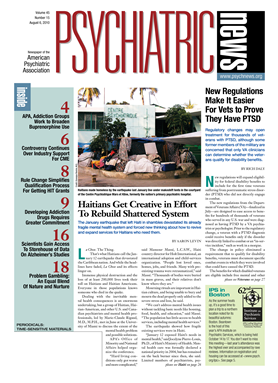The decision to hold the 2010 APA annual meeting in New Orleans, a city with ample allure due to its unique culture and music and its remarkable resilience in recovery after Katrina, seemed an optimistic choice. Optimism was indeed the general feeling as the member-in-training (MIT) representatives to the APA Assembly arrived in that balmy city, ready to discuss issues important to our profession.
Perhaps much like the reality check provided by the recent oil spill 100 miles away, a damper was placed on our work as the majority of Assembly representatives declined to debate, and subsequently voted down, an effort to provide us with a set of ethics guidelines regarding the relationships of psychiatrists with the pharmaceutical industry.
More importantly, we missed a valuable opportunity to provide our patients with a clear policy statement that in providing treatment, we make every effort to remain free from bias and have only their best interests at heart.
During the last year, APA Assembly members have been reviewing a draft report drawn up by an 11-member work group headed by past APA President Paul Appelbaum, M.D., an expert in the ethics of psychiatric practice and research. The May Assembly meeting was our chance to have an open, plenary-session debate and to pull together to establish a clear, comprehensive, living document that would provide our profession with ethical guidance in an increasingly important area.
The report was sent to an Assembly reference committee for deliberation. The outcome: The report died in the committee, and attempts to have a discussion thereafter were stymied. What seemed clear from the attempts of those who did not want to take advantage of an opportunity for discussion was that many Assembly members believed the proposed guidelines were too draconian and felt that they compromised their autonomy, despite the need to provide absolute clarity to patients.
If one looks at other professional bodies, it appears that we in psychiatry are behind the times when it comes to reining in potential conflicts of interest. In a profession focused on patient's psychological needs, we have failed to show those patients that we value their need for clarity more than we do the possible benefits we would derive from our ties with industry. We lag behind organizations like the Association of American Medical Colleges, Council of Medical Specialty Societies, and Institute of Medicine, which have drawn up clear sets of guidelines as extensive in scope as those proposed in the Appelbaum report.
In addition, the AMA recently referred a proposed set of similar guidelines to its Council on Ethical and Judicial Affairs.
That draft report was an attempt to provide a balanced set of guidelines to educate psychiatrists on the need to examine the basis of our clinical decision making in light of potential pharmaceutical industry influence. It also came as a bright spotlight is being shined on our interactions with industry. It was an attempt to say to patients that we are willing to self-examine, reflect, and make balanced decisions based on patient needs first and foremost.
We owe a lot to the pharmaceutical industry. Without product development, we would have a more limited armamentarium of medications, and some valuable research may not have been undertaken. However, we must be ready to recognize the perils of undue influence. We must be ready to assume that every patient has the potential to see in us a conflict of interest when we write a prescription with a branded pen or provide a free sample.
While it is clear that every psychiatrist has the capacity to make reasoned and autonomous professional decisions, we must be able to recognize that everyone can be influenced. The Appelbaum report attempts to make us aware of this, to reflect on it, and to integrate it in our decision making. All patients deserve the opportunity to trust that their physician makes all decisions based solely on their needs, and each patient deserves our pledge to uphold this principle.
Both MITs and early career psychiatrists in the Assembly strongly supported the Appelbaum report. Attempts by these members to move the report forward were unfortunately thwarted. But we are not done yet!
A new committee, the Corresponding Committee of Members in Training (CoMIT), which was recently formed to integrate and report on MIT activities within APA, has already held a postmortem regarding the Appelbaum proposal. The outcome is that the draft report is not dead yet. CoMIT has endorsed the report, and each of the MIT members has pledged to work by the guidelines to the best of their ability. In fact, the work is ratcheting up as CoMIT has already formed a work group that is meeting with Dr. Appelbaum to develop a strategy for getting the report on the agenda for discussion at the November Assembly meeting.
MITs are determined to provide clarity to patients. We hope, for once, the example of youth will be followed.

